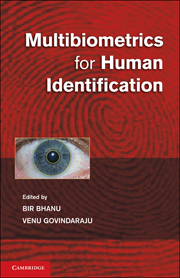Book contents
- Frontmatter
- Contents
- List of Contributors
- Preface
- Introduction
- PART I MULTIMODAL AND MULTISENSOR BIOMETRIC SYSTEMS
- PART II FUSION METHODS IN MULTIBIOMETRIC SYSTEMS
- PART III HYBRID BIOMETRIC SYSTEMS
- 8 Multiple Projector Camera System for Three-Dimensional Gait Recognition
- 9 Gait Recognition Using Motion Physics in a Neuromorphic Computing Framework
- 10 Face Tracking and Recognition in a Camera Network
- 11 Bidirectional Relighting for 3D-Aided 2D Face Recognition
- PART IV DATABASES AND SECURITY
- PART V PERFORMANCE OF MULTIBIOMETRIC SYSTEMS
- Plate section
10 - Face Tracking and Recognition in a Camera Network
from PART III - HYBRID BIOMETRIC SYSTEMS
Published online by Cambridge University Press: 25 October 2011
- Frontmatter
- Contents
- List of Contributors
- Preface
- Introduction
- PART I MULTIMODAL AND MULTISENSOR BIOMETRIC SYSTEMS
- PART II FUSION METHODS IN MULTIBIOMETRIC SYSTEMS
- PART III HYBRID BIOMETRIC SYSTEMS
- 8 Multiple Projector Camera System for Three-Dimensional Gait Recognition
- 9 Gait Recognition Using Motion Physics in a Neuromorphic Computing Framework
- 10 Face Tracking and Recognition in a Camera Network
- 11 Bidirectional Relighting for 3D-Aided 2D Face Recognition
- PART IV DATABASES AND SECURITY
- PART V PERFORMANCE OF MULTIBIOMETRIC SYSTEMS
- Plate section
Summary
Introduction
Multicamera networks are becoming increasingly common in surveillance applications given their ability to provide persistent sensing over a large area. Opportunistic sensing and nonintrusive acquisition of biometrics, which are useful in many applications, come into play. However, opportunistic sensing invariably comes with a price, namely, a wide range of potential nuisance factors that alter and degrade the biometric signatures of interest. Typical nuisance factors include pose, illumination, defocus blur, motion blur, occlusion, and weather effects. Having multiple views of a person is critical for mitigating some of these degradations.
In particular, having multiple viewpoints helps build more robust signatures because the system has access to more information. For face recognition, having multiple views increases the chances of the person being in a favorable frontal pose. However, to use the multiview information reliably, we need to estimate the pose of the person's head. This could be done explicitly by computing the actual pose of the person to a reasonable approximation, or implicitly by using a view selection algorithm. Solving for the pose of a person's head presents a difficult problem, especially when images have poor resolution and the calibration of cameras (both external and internal) is not sufficiently precise to allow robust multiview fusion. This holds especially true in surveillance applications when the subjects under surveillance often appear in the far- field of the camera.
- Type
- Chapter
- Information
- Multibiometrics for Human Identification , pp. 235 - 257Publisher: Cambridge University PressPrint publication year: 2011
- 3
- Cited by



